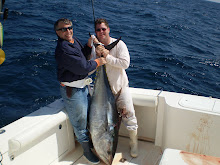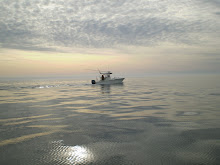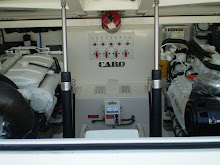
By Jim Field
As readers of this blog will know, Ernest Hemingway, a pioneering deep sea sportfisherman, is a particular hero of mine, and I have committed to writing occasional posts on his fishing endeavors, a few of which already reside in the library. Today's post kicks off a planned series on his custom fishing boat, which he christened the Pilar--the name of his leading heroine in For Whom the Bell Tolls, his novel of the Spanish Civil War.
The Pilar now rests permanently on terra firma on the grounds of his home in Cuba, the Finca Vigia, which the Castro government preserves as a museum. Being an impoverished nation, both the home and boat are in a terrible state of decay, reportedly undergoing a $1 million renovation (not really big money).
As an introduction to our subject, below I've copied text on the Pilar from a website dedicated to Key West history (www.explorekeywesthistory.com). On posts to follow, I'll try to elaborate on its design, specs, machinery, and so on.
Should be interesting research. (Note: I am not sure all of the facts offered below are accurate. We'll see which ones stand up over time.)
The (borrowed) text:
Returning to Key West from an African safari in 1934, Ernest Hemingway stopped off in New York to take a few meetings. At one with the editor of Esquire, Arnold Gingrich, Hemingway was given a $3300 advance for some short stories. He promptly took himself out to Coney Island to the Wheeler Shipyard and used the cash as down payment on a customized yacht.
Wheeler was known and rewarded for producing exceptional hand-crafted wooden boats. It had begun producing a pleasure yacht called the Playmate in 1920 and been very successful (the model would be produced until 1939.) Hemingway's modifications to the 38-foot version he ordered included a live fish well and a wooden roller spanning the transom to aid in hauling fish aboard. He also requested extra large fuel tanks (diesel) so he could stay at sea for longer periods of time. The boat had two motors? a 75hp for traveling and a 40hp for trolling. And he requested a flying bridge. The photo on the opening page shows Hemingway atop that flying bridge as the Pilar pulls out of Havana harbor.
The finished yacht cost $7500 and was brought to Key West and christened the Pilar. (Not only the name of the heroine in For Whom the Bell Tolls, Pilar is also the nickname for then-wife Pauline.) Through Key West friend and hardware store owner, Charles Thompson, Hemingway gained permission to dock her at the Navy Yard (the Navy was barely using it at the time.) This put the ship at dock only a few blocks from Hemingway's home on Whitehead Street. The photo at the top of this page is of Hemingway and Carlos Gutierrez on the bridge of the Pilar in Key West, 1934. Photo courtesy of JFK Library.
In 1940, when Ernest and Pauline divorced and he subsequently married Martha Gelhorn (whom he'd met at Sloppy Joe's,) they relocated to Cuba and built Finca Vigia (Lookout Farm)? the home on a hilltop overlooking Havana. Pilar was docked at Cojimar.
Pilar in Havana Harbor with EH, at left, on flying bridge

EH and long-time mate Carlos Gutierrez in wheelhouse; love custom of fishing in starched white cotton shirt and pants

Contemporary photo of Pilar, now protected from ravages of direct weather










Nice article, but I always note that the "drydocked" PILAR today exhibts chrome fittings
ReplyDeleteon the bow which did not exist until well after WWII!!! EH did not want chrome on the boat but
did permit the prewar bronze "arrow W's" on the bow port & starboard as well as our logo on the transom and the chrome ring on the bridgewheel. Wes Wheeler (son of designer Wesley L, Wheeler and grandson of the founder and president in 1933 Howard E. Wheeler)